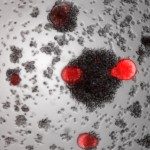Link to Pubmed [PMID] – 15687198
J. Bacteriol. 2005 Feb;187(4):1344-9
We have shown previously that when the Escherichia coli chromosomal lacZ gene is put under the control of an extended Shine-Dalgarno (SD) sequence (10 or 6 nucleotides in length), the translation efficiency can be highly variable, depending on the presence of AU-rich targets for ribosomal protein S1 in the mRNA leader. Here, the same strains have been used to examine the question of how strong ribosome binding to extended SD sequences affects the stability of lacZ mRNAs translated with different efficiencies. The steady-state concentration of the lacZ transcripts has been found to vary over a broad range, directly correlating with translation efficiency but not with the SD duplex stability. The observed strain-to-strain variations in lacZ mRNA level became far less marked in the presence of the rne-1 mutation, which partially inactivates RNase E. Together, the results show that (i) an SD sequence, even one that is very long, cannot stabilize the lacZ mRNA in E. coli if translation is inefficient; (ii) inefficiently translated lacZ transcripts are sensitive to RNase E; and (iii) AU-rich elements inserted upstream of a long SD sequence enhance translation and stabilize mRNA, despite the fact that they constitute potential RNase E sites. These data strongly support the idea that the lacZ mRNA in E. coli can be stabilized only by translating, and not by stalling, ribosomes.

